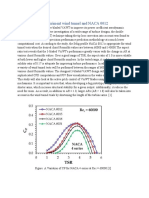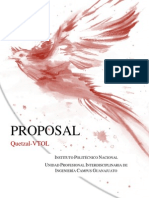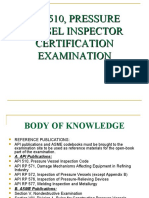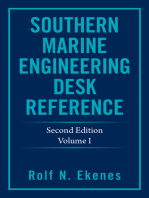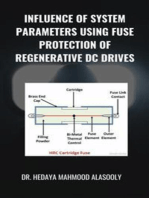Comparison of API-650 To AWWA D-100
Uploaded by
SAGARComparison of API-650 To AWWA D-100
Uploaded by
SAGARComparison of API-650 to AWWA D-100
This comparison between API-650 and AWWA D-100 is made from an "analytical" point of view. There may be other differences
between these two codes in the areas of: materials, fabrication, inspection, and maintenance.
AWWA D-100 allows the roof live load to be as little as 15 psf (pounds per square foot) based on temperature conditions.
API-650 specifies a minimum of 25 psf.
AWWA D-100 specifies a wind velocity factor of (V/100)2 for wind speeds greater than 100 mph. API-650 applies this velocity factor
to all wind speeds. AWWA D-100, in the definitions of section 3.5.1, specifically states that the minimum value of (V/100)2 is 1.0.
AWWA D-100 differs in the computation for the maximum height of the unstiffened shell. AWWA D-100 includes a wind pressure
term. API-650 does not include a pressure term.
AWWA D-100 employs an equation to compute shell thickness similar to the thickness equation in API-653 section 2.3.3.1. AWWA
D-100 references the bottom of the course, while API-653 references one foot above the bottom. The minimum shell course
thickness requirements of AWWA D-100 are the same as API-650.
AWWA D-100 specifies a maximum unit stress of 15000 psi (pounds per square inch), while API-650 provides TABLE 3-2, where
the allowable stress is a function of the material specified.
AWWA D-100 provides for three types (classes) of tanks: flat-bottom, ground-supported tanks, pedestal, and cross-braced elevated
tanks. The pedestal and cross-braced elevated tanks are specific to AWWA D-100, there are no allowances for these types of
tanks in API-650.
AWWA D-100 provides for seismic design in a manner very similar to the eighth edition of API-650, for bottom, ground-supported
tanks. The following comparisons are with reference to seismic design, and the eighth edition of API-650.
The zone coefficient tables in both codes are identical.
In the equation for overturning moment, AWWA D-100 uses the structure coefficient (K) where API-650 uses the
importance factor (I). The values of (K) are higher than the values of (I).
In the equation for overturning moment, AWWA D-100 uses a multiplier for the structural weight terms of 0.14. API-650
uses a value of 0.24.
In the equation for overturning moment, AWWA D-100 uses two multipliers on the sloshing term. AWWA D-100 applies
the "site amplification" and a multiplier based on the first sloshing mode period. API-650 uses a single multiplier, based on
the first sloshing mode period. The only common item is the computation for the period.
In AWWA D-100 the limit on "wl" is 1.28 HDG, while in API-650 the limit is 1.25 HDG.
AWWA D-100 uses a different equation for the width of the annular ring. Additionally, D-100 includes a limit on this width,
above which the tank must be anchored.
The limit for tank stability is higher in API-650 (1.57) than in AWWA D-100 (1.54).
The equation for stress when there is uplift is different between the two codes.
AWWA D-100 contains an appendix with alternate rules. This appendix recommends API-650 for certain H/D ratios.
AWWA D-100 specifies (c.3.2.3) a maximum thickness value.
AWWA D-100 provides a different table for the minimum thickness of the bottom annular
You might also like
- Scaffolding Structural Design Criterion SA469% (16)Scaffolding Structural Design Criterion SA42 pages
- Aircraft Weight and Balance Handbook: FAA-H-8083-1AFrom EverandAircraft Weight and Balance Handbook: FAA-H-8083-1A5/5 (1)
- AGENDA ITEM: 650-472 Load Combinations 8 Ballot: P Determined in F.4.1No ratings yetAGENDA ITEM: 650-472 Load Combinations 8 Ballot: P Determined in F.4.18 pages
- Methodology of Experiment Wind Tunnel and NACA 0012No ratings yetMethodology of Experiment Wind Tunnel and NACA 00126 pages
- Pes University: Ring Road Campus, BengaluruNo ratings yetPes University: Ring Road Campus, Bengaluru5 pages
- Safety Aspects in Substation Voltage UpratingNo ratings yetSafety Aspects in Substation Voltage Uprating6 pages
- Summary of FAA Airworthiness DirectivesNo ratings yetSummary of FAA Airworthiness Directives12 pages
- APPENDIX A (Revision 1 07/07/2011) UNOLS Rope and Cable Safe Working Load StandardsNo ratings yetAPPENDIX A (Revision 1 07/07/2011) UNOLS Rope and Cable Safe Working Load Standards24 pages
- Comments Resolution Discharge Filter Coalescer Skid - Foundation - Anchor - CVL ReplyNo ratings yetComments Resolution Discharge Filter Coalescer Skid - Foundation - Anchor - CVL Reply1 page
- AVA - A330 - AMM - FSN - 205 - 01-Jul-2024 - 12-11-28-650-804-A - Pressure Refuel With ManNo ratings yetAVA - A330 - AMM - FSN - 205 - 01-Jul-2024 - 12-11-28-650-804-A - Pressure Refuel With Man88 pages
- Api 510, Pressure Vessel Inspector Certification ExaminationNo ratings yetApi 510, Pressure Vessel Inspector Certification Examination62 pages
- UL Listed 100%-Rated Molded Case Circuit Breakers: Application Paper AP01200008ENo ratings yetUL Listed 100%-Rated Molded Case Circuit Breakers: Application Paper AP01200008E4 pages
- Summary of FAA Airworthiness DirectivesNo ratings yetSummary of FAA Airworthiness Directives12 pages
- Southern Marine Engineering Desk Reference: Second Edition Volume IFrom EverandSouthern Marine Engineering Desk Reference: Second Edition Volume INo ratings yet
- Aerospace Actuators V3: European Commercial Aircraft and Tiltrotor AircraftFrom EverandAerospace Actuators V3: European Commercial Aircraft and Tiltrotor AircraftNo ratings yet
- Influence of System Parameters Using Fuse Protection of Regenerative DC DrivesFrom EverandInfluence of System Parameters Using Fuse Protection of Regenerative DC DrivesNo ratings yet
- Eurocode 1: Actions On Structures: EN 1991, Part 1-4: Wind ActionsNo ratings yetEurocode 1: Actions On Structures: EN 1991, Part 1-4: Wind Actions3 pages
- Eurocode 1: Actions On Structures: EN 1991, Part 1-4: Wind ActionsNo ratings yetEurocode 1: Actions On Structures: EN 1991, Part 1-4: Wind Actions5 pages
- Applied Climatology: Urban Climate: Catherine Souch and Sue GrimmondNo ratings yetApplied Climatology: Urban Climate: Catherine Souch and Sue Grimmond12 pages
- Jonathan Livingston Seagull - Richard Bach - (SAW000) PDFNo ratings yetJonathan Livingston Seagull - Richard Bach - (SAW000) PDF39 pages
- ASHRAE-77 - Calculation of Wind & Stack Effect Infiltration in Tall BldgsNo ratings yetASHRAE-77 - Calculation of Wind & Stack Effect Infiltration in Tall Bldgs17 pages
- Statistical Downscaling and Bias Correction for Climate Research (Douglas Maraun, Martin Widmann) (Z-Library)No ratings yetStatistical Downscaling and Bias Correction for Climate Research (Douglas Maraun, Martin Widmann) (Z-Library)362 pages
- Vent Silencer Supports: Higher Inlet Pressure Smaller and Cheaper InstallationNo ratings yetVent Silencer Supports: Higher Inlet Pressure Smaller and Cheaper Installation2 pages
- Changes in Atmosphere As Indicator of Climate ChangeNo ratings yetChanges in Atmosphere As Indicator of Climate Change19 pages
- Experimental and Theoretical Study of Wind Loads and Mechanical Performance Analysis of HeliostatsNo ratings yetExperimental and Theoretical Study of Wind Loads and Mechanical Performance Analysis of Heliostats10 pages
- Unit 1. Introduction To Asian Studies AbstractionNo ratings yetUnit 1. Introduction To Asian Studies Abstraction13 pages



















